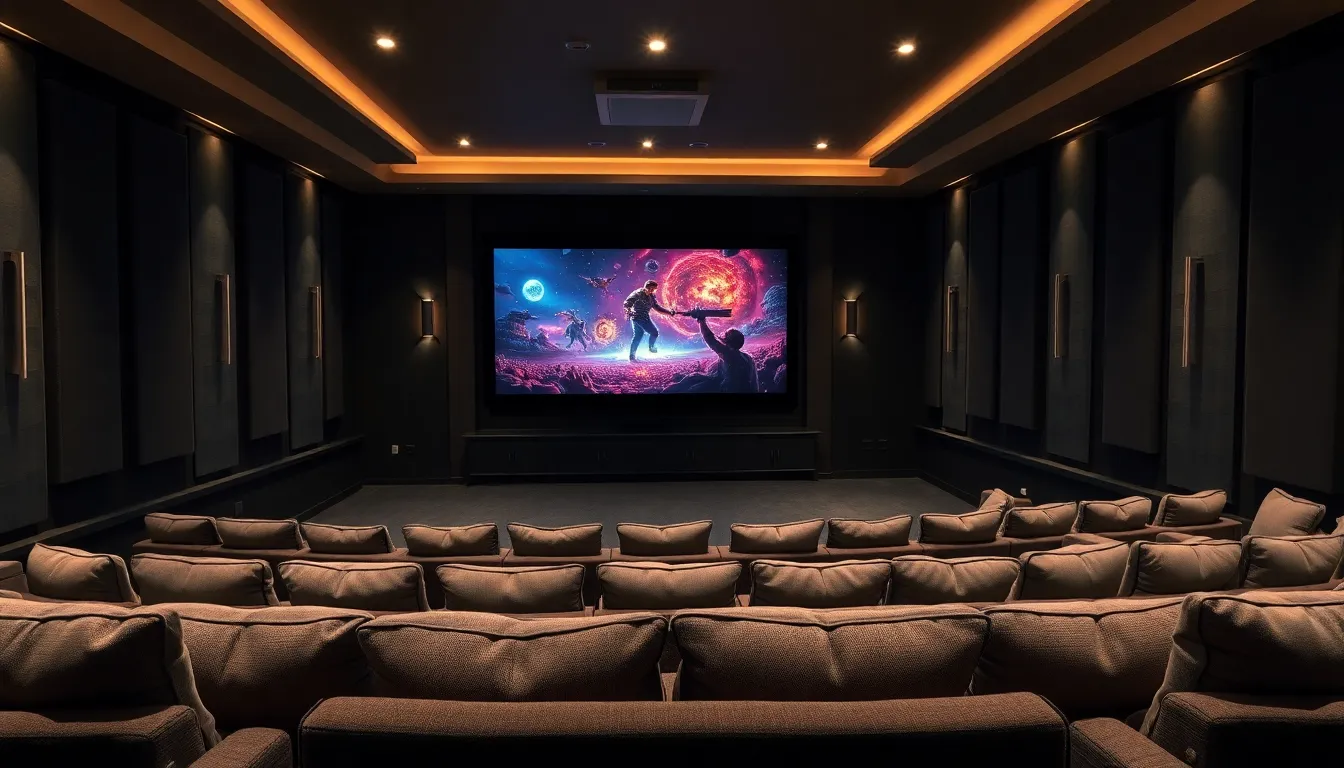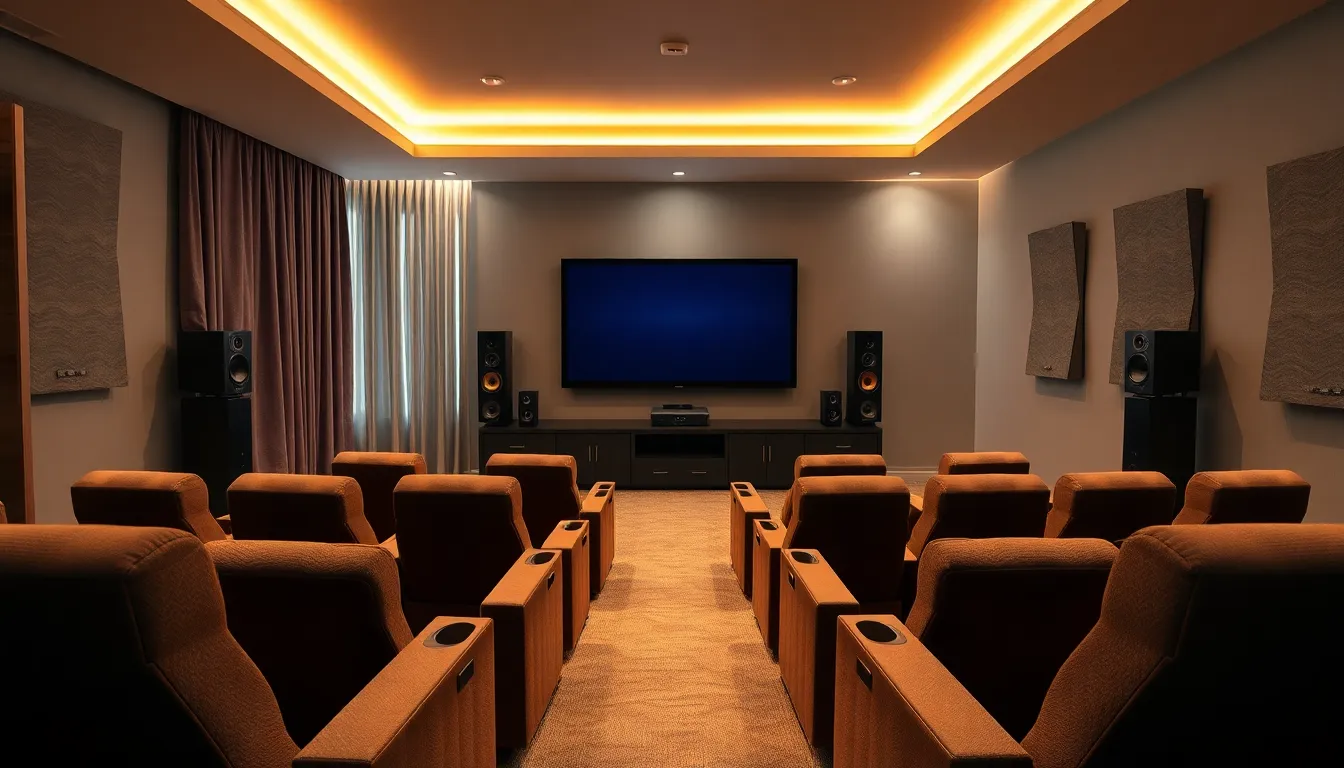Imagine transforming your living room into a cinematic paradise without stepping foot outside. Home theater design isn’t just about fancy gadgets and oversized screens; it’s about creating an immersive experience that makes movie night feel like a blockbuster event. With the right setup, popcorn won’t be the only thing popping—so will your excitement!
Table of Contents
ToggleOverview of Home Theater Design
Home theater design encompasses more than high-definition screens and advanced sound systems. It involves a careful selection of components that work harmoniously to deliver an exceptional viewing experience. Key elements include seating arrangements, audio systems, lighting, and acoustics.
Choosing the right seating contributes significantly to comfort during long movie marathons. Recliners and sectional sofas designed for optimal viewing angles enhance enjoyment.
Audio quality plays a pivotal role in the home theater experience. Surround sound systems create an immersive atmosphere, making viewers feel part of the story. Brands like Bose and Sonos offer systems tailored for various room sizes.
Lighting affects ambiance and mood. Dimmable lights and smart controls provide flexibility for different types of content. Incorporating light-blocking curtains also enhances picture quality by reducing glare.
Acoustics calibrate sound distribution. Sound-absorbing materials, such as acoustic panels, can minimize echo and improve clarity. Proper wall placement and speaker alignment optimize sound delivery throughout the space.
Designing a home theater room requires a systematic approach. Planning layouts, considering room dimensions, and accounting for sight lines ensure every seat provides a great view. Color schemes contribute to the visual experience, with darker tones reducing reflections.
Incorporating smart technology allows for easy control of all systems. Home automation enables users to manage lighting, sound, and video sources effortlessly.
Building a cohesive theme can elevate the overall experience. Whether choosing a modern or classic style, matching furnishings and decor visually rounds out the design.
Home theater design transforms ordinary movie nights into extraordinary events. Prioritizing comfort, sound, lighting, and aesthetics creates an environment that rivals commercial theaters.
Key Elements of Home Theater Design

Home theater design creates an immersive viewing experience, emphasizing comfort, sound, and lighting. Several key elements contribute significantly to this transformation.
Room Selection and Layout
Selecting the right room is crucial. Ideally, spaces with minimal outside noise and enough square footage enhance sound quality. Arranging seating in a way that each person enjoys an unobstructed view is essential. In addition, placing the screen opposite windows helps reduce glare. Consider using tiered seating to maximize sightlines for larger gatherings. Effective layout also considers pathways for easy movement, ensuring everyone can enjoy the cinematic experience.
Acoustic Considerations
Acoustics play a vital role in creating immersion. Using sound-absorbing materials like acoustic panels minimizes echo and enhances audio clarity. Installing carpets and heavy drapes further dampens sound, improving overall quality. Speaker placement is also critical; front speakers should align with the seating area for optimal sound delivery. Establishing a balanced sound with subwoofers in the right spots ensures deep, rich bass. Proper calibration of the audio system can greatly enhance the entire experience.
Visual Setup and Screen Types
The visual aspect of home theaters significantly impacts immersion. Choosing between LED, OLED, or projection screens influences both picture quality and viewing distance. Larger screens can create a more dramatic experience when placed at an appropriate height and distance from seating. Aspect ratios matter, as they dictate how content fits on the screen. Additionally, using a screen with anti-reflective coatings can enhance visibility in varying lighting conditions. Calibrating display settings optimizes brightness and color accuracy for a captivating movie experience.
Equipment and Technology
Home theater design integrates a variety of equipment and technology to create an exceptional viewing experience. Prioritizing the right components ensures enjoyment beyond typical movie nights.
Audio Systems
Surround sound systems provide immersive audio experiences. Brands like Bose, Sonos, and Dolby Labs specialize in systems varying from compact soundbars to full multi-channel arrangements. Proper speaker placement enhances overall sound delivery. Investing in sound-absorbing panels also improves acoustics, minimizing echo and ensuring clarity. In addition, compatibility with streaming services allows seamless playback of high-definition audio formats, elevating the overall experience.
Video Systems
Choosing the right display technology is crucial. LED and OLED screens offer sharp images and vibrant colors, while projection systems create a larger-than-life cinematic feel. Factors like room size and viewing distance determine the ideal screen size. Calibration of video settings ensures optimal picture quality, contributing to a captivating viewing environment. Anti-reflective coatings on screens further minimize glare, enhancing clarity in various lighting conditions.
Streaming and Control Options
Smart home systems simplify control over entertainment setups. Universal remotes and mobile apps provide easy access to media libraries and streaming platforms. Integration with voice assistants enables hands-free operation, adding convenience. High-speed internet connections facilitate smooth streaming of 4K content, improving overall viewing quality. Additionally, advanced receivers support multiple input sources, ensuring compatibility with various devices.
Aesthetic Aspects
Aesthetic considerations significantly impact home theater design, enhancing the overall viewing experience. Key elements include lighting design and furniture selection.
Lighting Design
Lighting sets the mood for a cinematic atmosphere. Dimmable LED lights allow for precise control over brightness levels, enhancing the viewing experience. Incorporating smart lighting solutions further offers convenience, as they can be adjusted remotely. In addition, light-blocking curtains improve picture quality by reducing glare on screens. Accent lights can highlight decor elements or enhance wall designs, creating an inviting space. Overall, combining various lighting techniques elevates the ambiance, ensuring the home theater remains captivating.
Furniture and Decor
Furniture selection directly influences comfort during movie nights. Recliners and sectional sofas provide flexible seating arrangements that accommodate multiple viewers. Choosing high-quality materials ensures durability and enhances aesthetics. Decor elements, like themed artwork or custom wall colors, complement the overall design, reflecting personal taste. Arranging furniture for optimal sightlines promotes a great view from every seat. Accessories such as throw pillows and blankets can add comfort while enhancing visual appeal. Integrating stylish yet functional pieces transforms the home theater into a cozy escape.
Budgeting for Your Home Theater
Budgeting becomes a crucial aspect of home theater design. Establishing a budget early facilitates informed decisions about components and technologies. Consider the costs associated with major items such as displays, speakers, and seating.
Displays, whether LED, OLED, or projection systems, typically range from $500 to $3,000, depending on size and quality. For audio systems, expect to spend between $300 for basic setups to over $2,000 for high-end surround sound configurations. Configuration of multiple speakers enhances the experience, with proper placement improving sound distribution.
Seating arrangements also impact budget considerations. Recliners may cost around $200 each, while sectional sofas could range from $1,000 to $3,000 based on material and design. It’s advisable to allocate funds for furniture that maximizes comfort during movie marathons.
Lighting mechanisms play a significant role in budget planning as well. Dimmable LED lights and smart controls can vary from $50 to $350, depending on sophistication. Incorporating light-blocking curtains may require an additional investment of $100 to $600 based on the material and size.
Acoustic treatment often gets overlooked but carries importance in the budgeting process. Sound-absorbing panels, frequently ranging from $30 to $200 each, improve overall sound clarity, leading to an enhanced viewing experience.
Include expenses for aesthetic elements, such as themed artwork or decorative items, which may range from $50 to $1,000, depending on complexity. By outlining each segment of the budget clearly, homeowners can realize their ideal home theater experience without financial strain.
Creating a home theater isn’t just about technology; it’s about crafting an experience that captivates and entertains. By thoughtfully selecting seating, audio systems, and lighting, homeowners can elevate their movie nights into memorable cinematic events.
Attention to detail in acoustics and aesthetics further enhances the atmosphere, ensuring every element works in harmony. With a clear budget and a vision in mind, anyone can design a space that reflects personal style while providing comfort and immersion.
Investing time and effort into these aspects transforms any room into a cozy escape, making home theater design a rewarding endeavor for movie enthusiasts.




